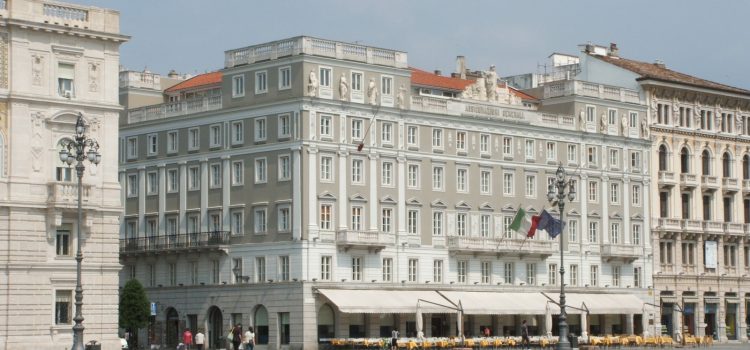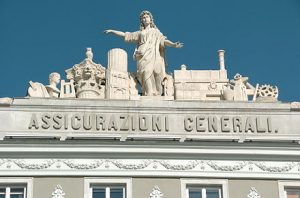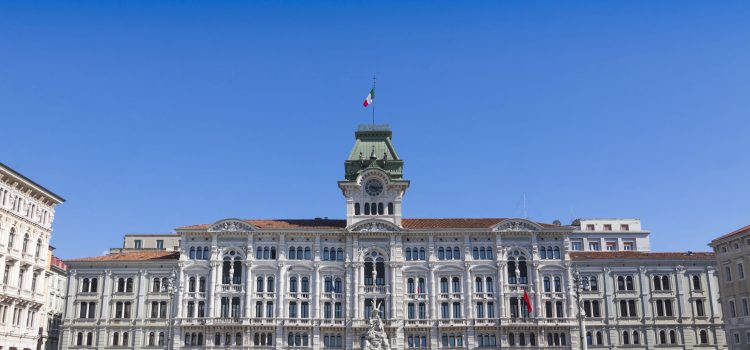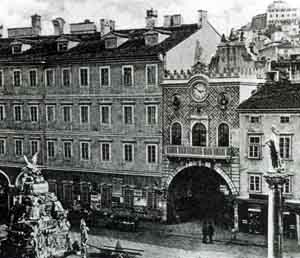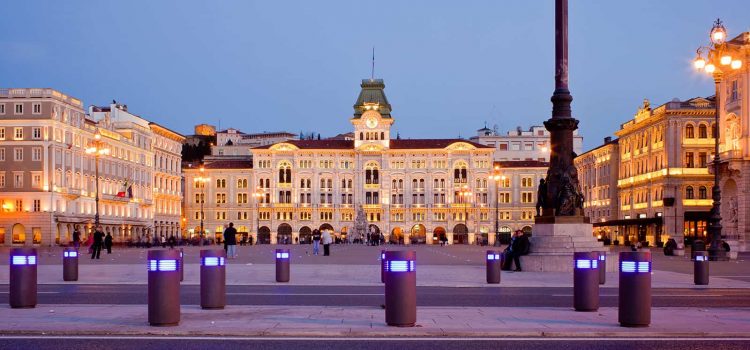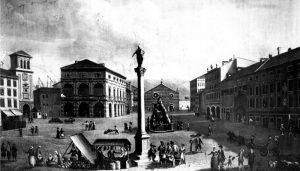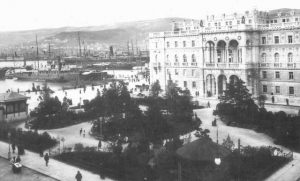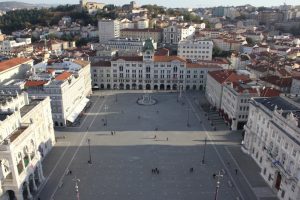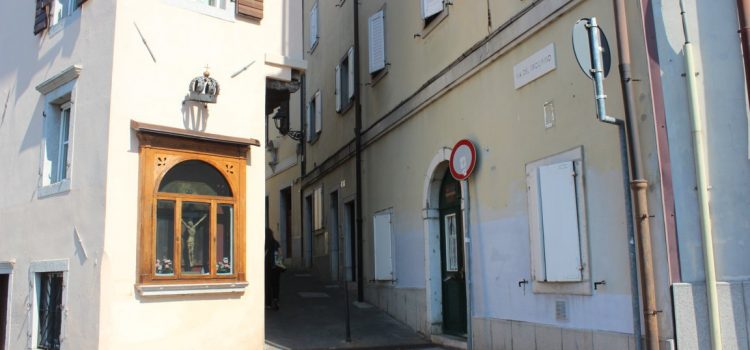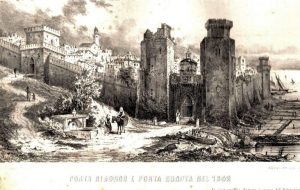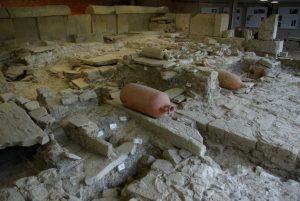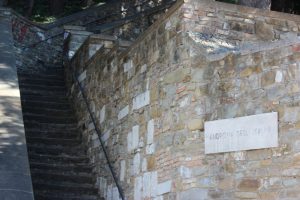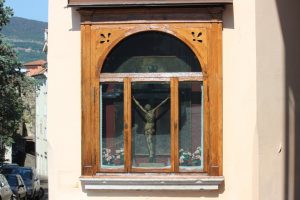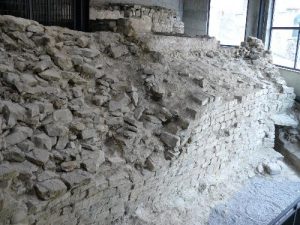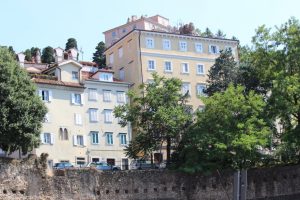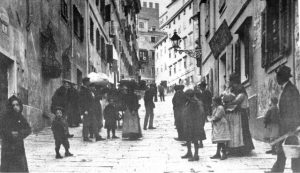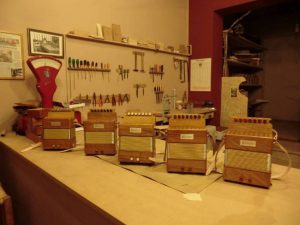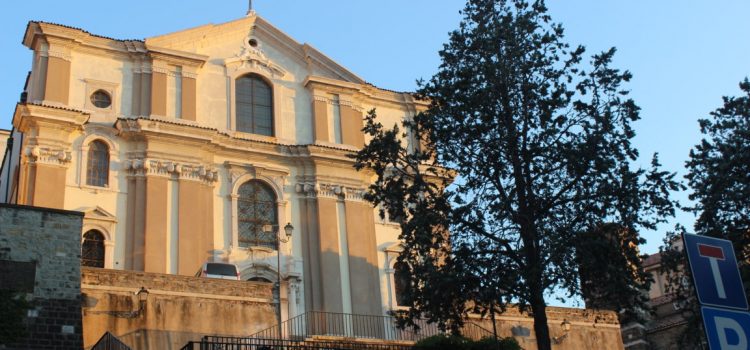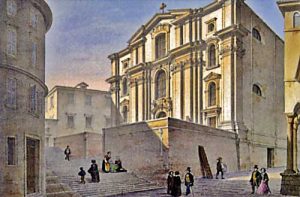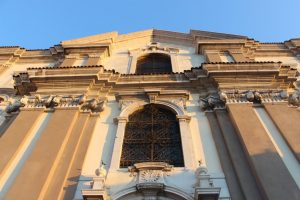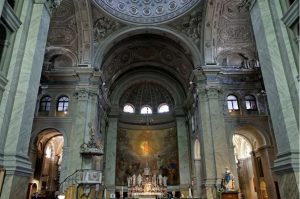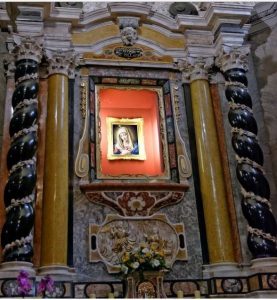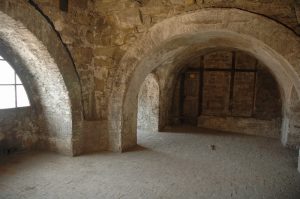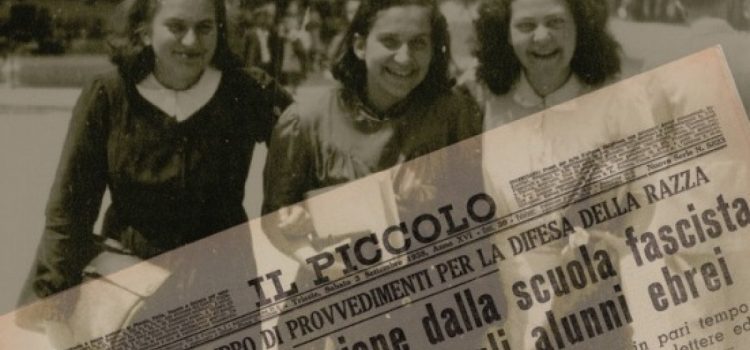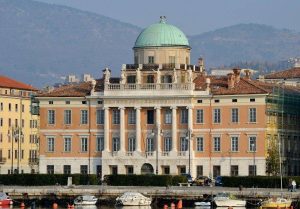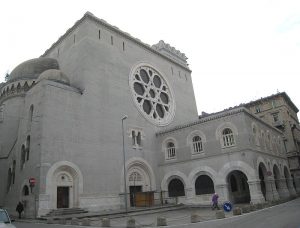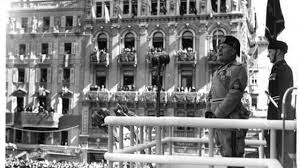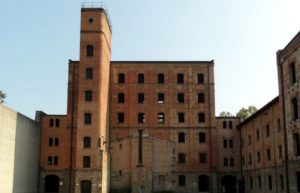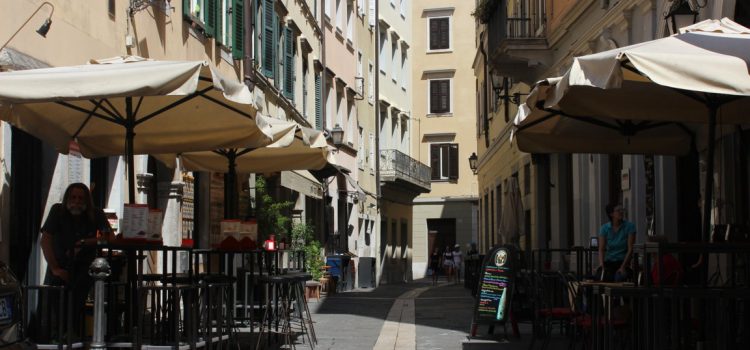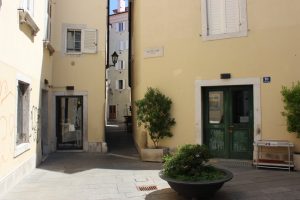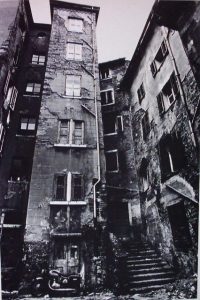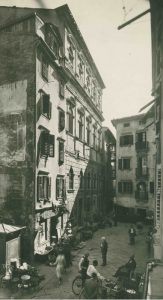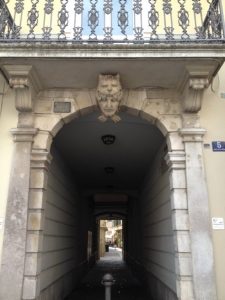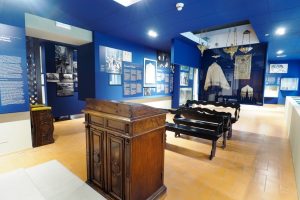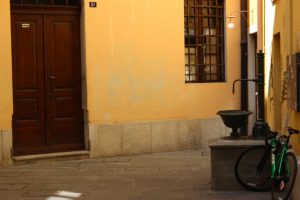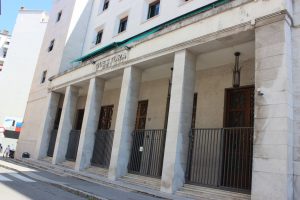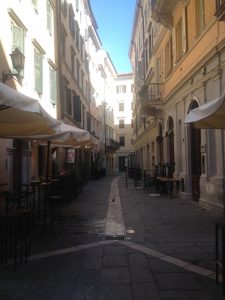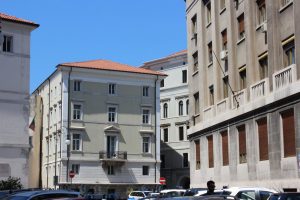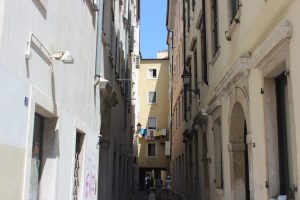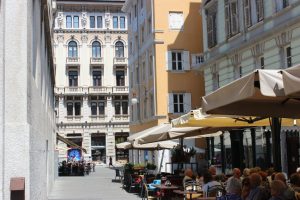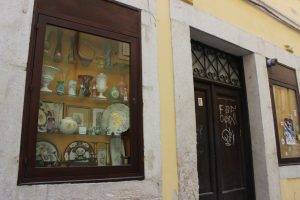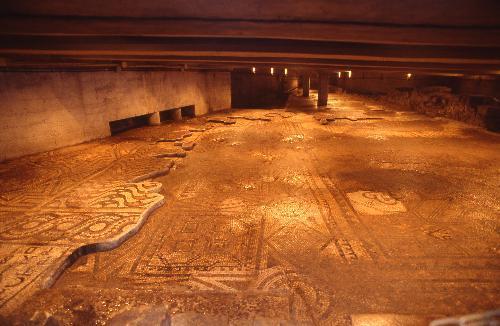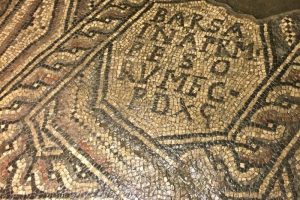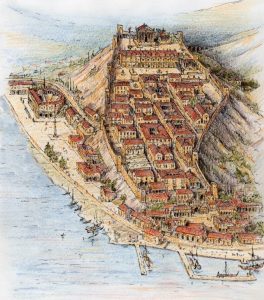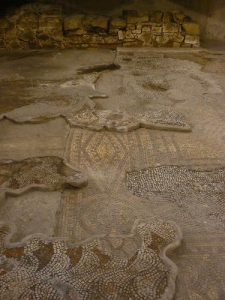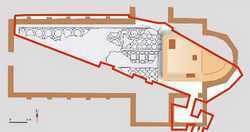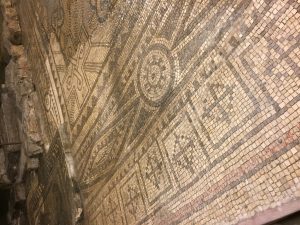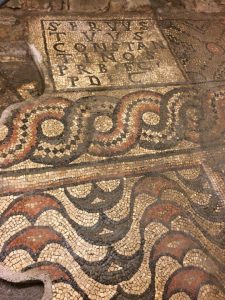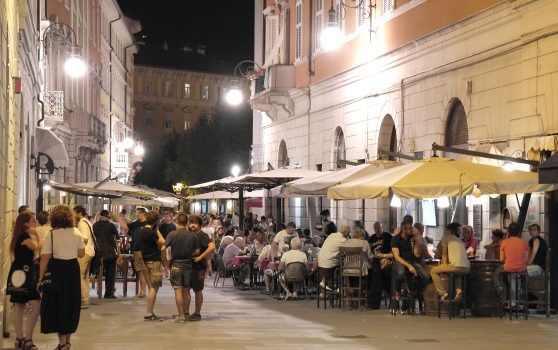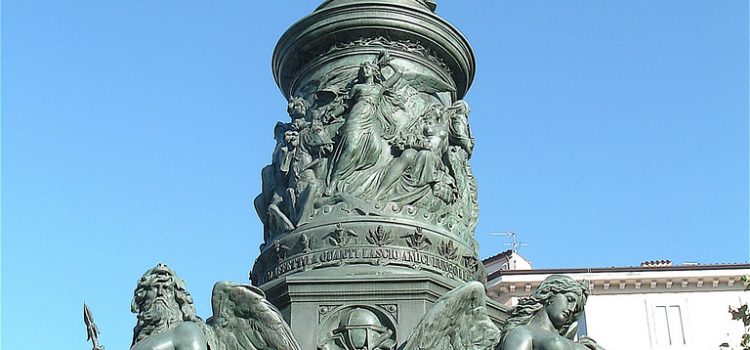PALAZZO STRATTI – PIAZZA UNITA’ D’ITALIA – TRIESTE
The rich cloth merchant, the Greek Nicolò Stratti, an important figure in the city of Trieste in the early nineteenth century, in 1839, ordered the architect Antonio Buttazzoni to design a neoclassical style building to the north-east of the square and to remember the style of Palazzo Carciotti which for forty years dominated the banks.
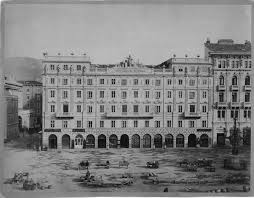
The façade is crowned by a balustrade and completed by a sculptural group, which once stood on the postic façade, the work of the Venetian sculptor Luigi Zandomeneghi.
In the allegorical work, Trieste is represented by a woman surrounded by symbols that praise the cultural and economic growth of the city, such as technological development (George Stephenson’s locomotive given to Austria in 1837 to improve the Trieste-Vienna railway), urban planning (a capital), artistic (the zither, for music, the palette for painting and the bust for sculpture), work (an anvil, a hammer and an anchor) and, finally, the growth of reason but also the presence always of the mystery of darkness (an owl, an animal sacred to Minerva).
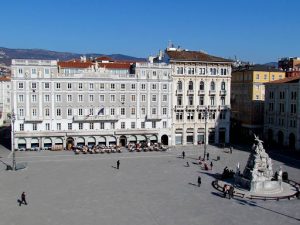
In 1846, due to financial difficulties of the Stratti, the building was purchased for 400,000 florins by Assicurazioni Generali. On the ground floor of the building there is the historic Caffè degli Specchi inaugurated in 1839 but completed only in 1846 when the ownership of the building passed to Assicurazioni Generali. The facade of the building was completely renovated in 1872 on a project by the architects Geiringer and Righetti.
PALAZZO DEL MUNICIPIO – PIAZZA UNITA’ D’ITALIA – TRIESTE
At the entrance to Piazza Unità d’Italia, coming from Piazza della Borsa, where the Palazzo del Magistrato once stood,
in 1875 the Palazzo del Municipio was designed by the architect Giuseppe Bruni. The style of the facades is characterized by a mixture of Parisian style and Germanic mannerism. 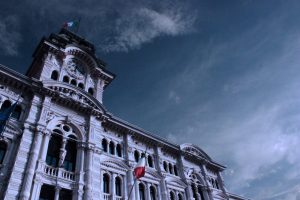
The Palazzo initially did not appeal to the people of Trieste who nicknamed it “Cheba” palace, or “Cage” palace, due to the shape that resembles a huge cage for birds, but also “Sipario” palace, since with its imposing size it was able to hide the ruins and the ugliness of the houses of the Old Town that were behind it. The ground floor is made up of round arches that reproduce the idea of a portico, while on the upper floors there are numerous windows divided into mullioned windows and three-mullioned windows.
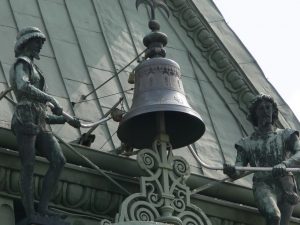 Composed of two lateral bodies of four floors in height, and a central body higher than one floor and characterized by the clock tower, on top of which two bronze Moors, nicknamed Micheze and Jacheze from Trieste (Their names derive from the Slovenian “Mihec” and “Jakec” which means Michael and James), mark the time every quarter of an hour. The first twelve chimes of noon were heard on January 14, 1876.
Composed of two lateral bodies of four floors in height, and a central body higher than one floor and characterized by the clock tower, on top of which two bronze Moors, nicknamed Micheze and Jacheze from Trieste (Their names derive from the Slovenian “Mihec” and “Jakec” which means Michael and James), mark the time every quarter of an hour. The first twelve chimes of noon were heard on January 14, 1876.
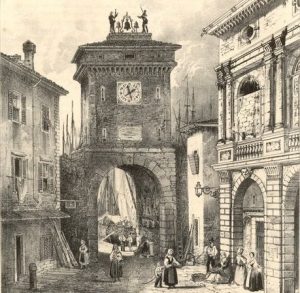 The two statues recall the two Moors installed in 1517 on the Clock Tower, also called Torre del Porto, or Torre del Mandracchio which was the door to the square (then Piazza Grande or Piazza San Pietro) which overlooked the ancient port of the city .
The two statues recall the two Moors installed in 1517 on the Clock Tower, also called Torre del Porto, or Torre del Mandracchio which was the door to the square (then Piazza Grande or Piazza San Pietro) which overlooked the ancient port of the city .
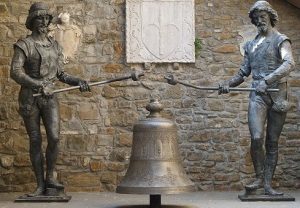 Currently on the Town Hall tower are two copies of the original statues found at the entrance to the castle of San Giusto.
Currently on the Town Hall tower are two copies of the original statues found at the entrance to the castle of San Giusto.
PIAZZA UNITA’ D’ITALIA – TRIESTE
Initially called San Pietro for the existence in the square of the church of San Pietro, demolished in the second half of the nineteenth century, but also known as Piazza Grande, to distinguish it from the Small Square located behind the Palazzo del Comune.
The square was much smaller than the current one and closed, on the side facing the sea, by the walls and the Torre del Porto, which overlooked the “Mandracchio”, the ancient port that extended up to half of the current square.

In the evening, a suggestive illumination with blue lights recalls the ancient coast. While on the opposite side the square was bounded by the old Town Hall, the seat of the city administration since the Middle Ages.
During the 1800s, works were made to open the square towards the sea, bury the Mandracchio and create a large garden surrounded by buildings built from the eighteenth to the early twentieth century. After the First World War, with the annexation of Trieste to Italy, the square took the name Unit and from 1955 it became Piazza Unità d’Italia.
12.280 sqm. rectangular plan and on one side opens directly onto the sea. It is the largest square in Europe overlooking the sea.
CITTAVECCHIA – VIA DONOTA – TRIESTE
Often, to return to my home
I take a dark street in the old city.
Yellow is reflected in some puddle
a few lights, and the street is crowded.
Here among the people who come and go
from the tavern to the house or to the brothel,
where the detritus are goods and men
of a great sea port,
I find, passing, infinity
in humility.
Here a prostitute and a sailor, the old man
what a blasphemy, the female who quarrels,
the dragon who sits at the shop
of the fryer,
the tumultuous girl gone mad
love,
they are all creatures of life
and pain;
the Lord is stirred in them, as in me.
Here I feel humble in company
my thoughts become
purer where the way is uglier.
“Cittavecchia” Umberto Saba
Behind the Roman Theater, in the heart of the Old Town district, following the slope of the Colle di San Giusto, there is one of the oldest streets in Trieste “Via Donota” considered as the road that connected Aquileia with the central part of the ancient Tergeste, on the extension of the Cardo maximus.
In the Middle Ages at the entrance to the road stood the Torre-Porta Donota, a crenellated tower with a square plan, equipped with a drawbridge and a moat full of water, built to defend one of the main entrances within the city walls and to the castle of San Giusto. After the urban development of the nineteenth century, the original facade of the gate was no longer visible because it was covered by a modern building and Piazza Donota was built in the space in front, characterized by the construction of new buildings.
From 1981 to 1986 during some building renovation works, part of the medieval structures of the Tower were found but also Roman ruins, a building dating back to the 1st century, graves from the 4th century and other burials and amphorae, all carefully preserved in the Antiquarium in via Donota, opened by the Superintendency on 14 December 1985 and located on the corner of via Donota and via Battaglia.
In the Androna degli Scalini that connects via del Teatro Romano and via Donota, there was a public wash house that worked until 1936.
At the corner of via Donota and via del Crocefisso there is a shrine called “Pontal de Cristo”, hence the name of the street. The original perhaps of medieval origin was destroyed by fire in 1931 and replaced by a first that was stolen on 23 December 1980 together with the crown above and, then, by a second made by the sculptor Renzo Possenelli.
The building in Via Donota at no. 16 stands on a pre-existence of medieval origin as confirmed by the excavations conducted in 1982 which made it possible to identify the original masonry, consisting of well-squared sandstone blocks but also to discover fragments of tiles, yellow and red plaster and parts of mosaic tiles black, which testify to the presence of ancient houses.
On the main facade of the building there is a medieval mullioned window with arches in Istrian stone, with a slender central column and a capital in the shape of a truncated and overturned quadrangular pyramid. Another window, of which only a few traces remain, opens at the left corner of the elevation.
Via Donota was one of the main streets of the city full of shops and inhabited by many sea workers.
In this street the Ploner brothers created a new accordion keyboard, called Trieste-style, in their musical instrument workshop, which achieved great success between the end of the 1800s and the beginning of the 1900s.
CHIESA DI SANTA MARIA MAGGIORE – TRIESTE
In the historic center of Trieste and a few steps from the Roman Amphitheater, on a large staircase built in 1956, stands the Church of Santa Maria Maggiore, a unique example in Baroque style among the churches of the city. The church is popularly known as the Jesuit church to remember that its construction was commissioned by the Society of Jesus, which arrived in Trieste in 1619. After the construction of the Jesuit College, in 1627, which later became an Austrian criminal prison and an Italian women’s prison, it was the first stone for the construction of a large church dedicated to the Immaculate Conception of the Blessed Virgin Mary.
The works went on for a long time and continued even after the consecration of the Church in 1682 and the suppression of the Society of Jesus in 1773. The Church after the canonical extinction of the parish of S. Giusto Martire in 1774 and due to its size and architectural beauty became one of the most important religious buildings in Trieste.
The interior of the Church is attributed to the Modenese Jesuit, perhaps a designer, Giacomo Briani, while the eighteenth-century facade to the Trentino Jesuit, painter and architect, Andrea Pozzo. Above the central door of the majestic and monumental facade, in Baroque style, a sun-shaped frieze with the letters MRA (Mary Queen of the Angels) stands out and a small Jesuit hammer is visible in the wrought iron grate below.
The interior has a Latin cross plan and is divided by two rows of pillars into three naves. The hemispherical octagonal dome was destroyed by fire and rebuilt in 1817 by Giovanni Righetti. In particular: in the left aisle there is the chapel of the baptismal font in white marble, on which stands the statue of John the Baptist and the vault of the ceiling is frescoed with scenes from the New Testament;
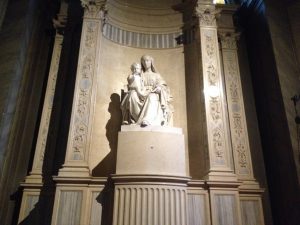
in the right aisle stands the altar dedicated to the Madonna delle Grazie erected in 1853 by Baron Pasquale Revoltella in memory of his mother Domenica; the large canvases of the Via Crucis appear on the side walls of the aisles, a work of great value by the Trieste artist Carlo Wostry; the statue of the risen Christ rests on the dome of the tabernacle of the main altar; in the apse a large tempera fresco depicts the Apotheosis of the Immaculate Conception. To the left of the main altar there is the Chapel of the Crucifix and the altar “of the Good Death”, a gift from Bishop Giovanni Francesco Mueller in 1713 and, on the left side, among the works you can see the canvas of Christ in the tomb, by Carlo Wostry of 1894.
The chapel to the right of the main altar is dedicated to the Madonna della Salute and inside is the painting of the Virgin, donated in 1841 by Domenico Rossetti. Triestines are particularly devoted to the Madonna della Salute. Since 1849, the year in which the cholera epidemic broke out in the city, every year, on November 21st, the people of Trieste gather in the Church to renew their devotion to the Madonna. Bishop Antonio Santin in 1957 wanted to place the chapel with the miraculous statue of the Madonna dei Fiori in via del Teatro Romano at the origin of the feast of 21 November. The sixteenth-century marble bust depicting the Madonna and Child was found, around 1830, by an innkeeper whose nickname was Fior and on 15 October 1849 to implore the cessation of cholera it was carried in procession and on 21 November of the same year brought back in procession by grace received.
Under the Church of Santa Maria Maggiore there are the Jesuit Undergrounds which have always attracted the attention of art scholars and mystery lovers. Authors of the nineteenth and twentieth centuries such as Pietro Kandler, Ettore Generini, Giovanni Machorsich and the collector Diego de Henriquez, took care of the basement of the college. They retraced and described them. Today the fascinating rooms of the underground can be visited in complete safety thanks to the interest of the Parish of Santa Maria Maggiore and the volunteers of the Urban Speleology Section of the Adriatic Speleology Society.
GHETTO EBRAICO 1 – TRIESTE
In 1810 the religious and civil equality of all citizens was proclaimed. Any form of discrimination against Jews still in force is eliminated.The return of Austria and the period of the Restoration, characterized in all the territories of the Habsburgs by a strong centralism and a capillary police control, restore some prohibitions against the Jews ( including that of the public service, the prohibition of owning properties or the need for a permit to get married). , grains and oriental aromatic herbs. The nineteenth century saw the economic life of the Trieste emporium develop in an impetuous way and marked the moment of greatest civil and cultural flowering of the Jews of Trieste. The first insurance and shipping companies were born in the port of the Habsburgs, while maritime traffic experienced an unprecedented impulse.
The Jewish component continues to play a leading role, which is still witnessed today by the sumptuous palaces that characterize the city: Hierschel palace along the Grand Canal; Palazzo Carciotti, the first and most original example of neoclassical in Trieste, designed by the architect Matteo Pertsch, the first headquarters of Assicurazioni Generali;
Between the 19th and 20th centuries, the city experienced a steady stream of Jews fleeing the pogroms of Eastern Europe and Russia and headed for Palestine or the Americas. Until the outbreak of the Second World War, Trieste was the main port of embarkation for Israel, so much so that it earned the title of “Shaar Zion”, “Gate of Zion”. A clear sign of the importance reached by the Trieste community in the first half of the twentieth century is the construction of the monumental synagogue in Piazza Giotti, still today one of the symbols of multi-religious Trieste. The Great Synagogue
In September 1938, in a speech delivered precisely in Trieste, in Piazza Unità, Benito Mussolini announced the promulgation of the racial laws. Thus the complete expulsion of Jewish citizens from civil society is sanctioned. Their right of ownership is limited and, with retroactive effect, Italian citizenship is revoked from those who obtained it after 1919, thus creating about 500 stateless persons without any protection, also unable to emigrate because they lack a passport. 1939, the Jewish community which until then had represented a fundamental element of reference and cohesion was dissolved. Since 1941, also in the wake of the war, the persecution becomes increasingly bitter. Accidents and ill-treatment followed one another until the devastation, on July 18, 1942, of the majestic Synagogue. Intimidations and aggressions also marked 1943, the year that represented a dramatic turning point for the Community of Trieste, on 8 September the plan was triggered. of German occupation and Trieste, capital of the Adriatic coast, was placed under direct German control. Anti-Semitic politics now turns to the final solution.
Between November and December 1943, the Risiera di San Sabba, a complex of industrial buildings from the early twentieth century, once used for rice husking and then as barracks, was transformed into the only extermination camp built in Italy. To manage it are called military and officers already experienced in the atrocities of the final solution in Poland. At the Risiera, between 4 and 5 thousand people die, mostly political opponents, Italian, Slovenian and Croatian partisans. There are fewer than a hundred Jewish victims. For Jews, the San Sabba camp is in fact only a temporary accommodation pending deportation, usually towards Auschwitz.The Trieste community is deeply affected. At least 700 people, 10 percent of Italian Jews were deported and only 19 will return from the extermination camps, mostly women, who will witness the horror they suffered. After the war, a thousand survivors hiding in Italy or Switzerland return to the city. Many of them will emigrate to Palestine or the Americas. About 1,500 Jews remain in Trieste and in the mid-1960s a net imbalance between deaths and births will reduce their number by about 500. Today the Jewish Community of Trieste has almost 600 members and is considered an average reality at national level.
JEWISH GHETTO – TRIESTE
Umberto Saba, Autobiography
.
It was established by Leopoldo I of Habsburg in 1696 in the then peripheral area of court Trauner and on November 28, 1696 by imperial decree, it was transferred to Riborgo, the commercial heart of Trieste, welcoming the protests of the Jewish community that wanted to be closer to the places where the economic life of the city took place.
The Jewish population is assigned 13 houses around the square, known as the Jewish Schools, and along two parallel districts that divide the neighborhood in a north-south direction. In 1697, after other houses were requisitioned, about a hundred Jews entered the ghetto.
The ghetto is accessed from the Portizza and is surrounded by a high wall with three entrance doors: in piazza del Rosario, at the end of via Beccherie and in Riborgo, at the time guarded night and day by Christian guards.
The proclamation of the free port of Trieste in 1719, by Charles VI of Habsburg, brings with it privileges and freedoms for all and also for the increasingly numerous Jewish community and which assumes, with the flourishing of traffic and commerce, a central role in the city. In 1748 the first synagogue was built, the Shola n.1, of the German rite, destroyed by a fire in 1822. It was rebuilt three years later and remained active until 1935 as an oratory. In 1771 Maria Theresa finally granted the Jews of Trieste two sovereign licenses, real regulations which provide, among other things, the exemption from the obligation to wear the distinctive yellow sign and the abolition of the special tax on the person (Leibsteuer) , which had to be paid by every Jew to enter another city. In 1784 the Emperor Joseph II instituted the Licenses of Tolerance. Jews are thus admitted to the office of deputies on the Stock Exchange, to exercise professional activities hitherto prohibited and at the university and, the following year, segregation was abolished. Other synagogues were built which were destroyed along with a large part of the ancient ghetto during the rehabilitation carried out by fascism from 1928 to 1937.
From the demolition of the synagogues, objects of worship have been preserved in the Museum of Carlo and Vera Wagner in via del Monte 7. Between 1797 and 1813 Trieste undergoes the occupation of Napoleonic troops three times, which marks the conquest of the Jews. rights.
Androna del Pane named after the Servolane bread vendors who arrived in the city with their baskets of warm bread.Androna del Pane was also named Androna della Rizza which was the name of a prostitute who lived in Androna and was well known in the ‘environment. In these streets of Cittavecchia there were about 40 brothels and more than 350 prostitutes who practiced the trade, all regularly registered and with medical assistance. The tiny brothel called “The cubic meter” is perhaps foreshadowed in a letter from Joyce to Svevo in which the Irish writer recalls “the brothels of public insecurity” in the area.
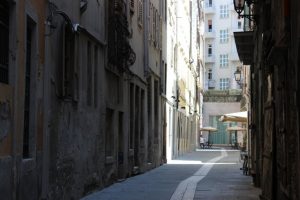 Via Beccherie is one of the oldest streets in the city. In 1754, a new municipal slaughterhouse was built nearby and this road was destined for meat sellers.
Via Beccherie is one of the oldest streets in the city. In 1754, a new municipal slaughterhouse was built nearby and this road was destined for meat sellers.
The last stretch of via Beccherie, towards the current Largo Riborgo, was destroyed in 1934 and the Casa del Fascio, the current Police Headquarters, was built in its place in 1938.
Via del Ponte runs from via Beccherie to Piazza Vecchia and until 1749 there was a wooden bridge that crossed the Canale della Portizza, known as the “Piccolo” or “del Vino” canal, where cargo boats used to forward.
Piazza Vecchia si contraddistingueva da Piazza Nuova, la piazza situata dietro il palazzo del Comune che in futuro diventerà prima Piazza Grande e poi Piazza dell’Unità d’Italia.
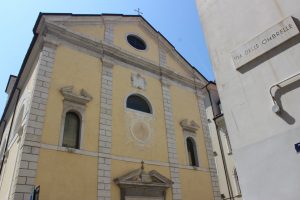 Piazza Vecchia un tempo era nota come Piazzetta del Rosario per la presenza di una confraternita di cittadini devoti che,nel 1613 chiesero la costruzione di una cappella detta del Rosario che per le leggi di Giuseppe II, fu chiusa nel 1784 e venduta alla Comunità evangelica di Cofessione Augustana, la quale ne mutò il titolo dedicandola alla SS. Trinità. Il fregio con dentro il triangolo e l’occhio, emblema del mistero della Santissima trinità. è ancora presente sulla facciata e sull’arco del presbiterio. nel 1869 il Comune demolita la chiesa di San Pietro, cappella comunale, la riacquistò destinandola a nuova cappella civica, facendo costruire in cambio la chiesa di Largo Panfili.
Piazza Vecchia un tempo era nota come Piazzetta del Rosario per la presenza di una confraternita di cittadini devoti che,nel 1613 chiesero la costruzione di una cappella detta del Rosario che per le leggi di Giuseppe II, fu chiusa nel 1784 e venduta alla Comunità evangelica di Cofessione Augustana, la quale ne mutò il titolo dedicandola alla SS. Trinità. Il fregio con dentro il triangolo e l’occhio, emblema del mistero della Santissima trinità. è ancora presente sulla facciata e sull’arco del presbiterio. nel 1869 il Comune demolita la chiesa di San Pietro, cappella comunale, la riacquistò destinandola a nuova cappella civica, facendo costruire in cambio la chiesa di Largo Panfili.
The name of Via delle Ombrelle, from Via Beccherie to Piazza Vecchia, derives from the presence of the residence of a Brescian dedicated to repairing umbrellas: Giacomo Malgarini.
In via Malcanton fino al 1753 c’erano le mura dell’antica Trieste che in questa strada formavano un angolo detto in dialetto “canton” e poichè era frequentata da malviventi da qui il nome di Malcanton.
Le vie del quartiere sono tuttora sede di negozi e di professioni tipiche dell’antiquariato, della vendita e del restauro di mobili, suppellettili e libri nonchè ristoranti e pub caratteristici.
BASILICA PALEOCRISTIANA – TRIESTE
Its discovery dates back to the first half of the 19th century, when Domenico Rossetti, in 1825, designed the mosaics of the apse of the church which was brought to light only at the beginning of the 60s of the last century. In 1963 some workers of the Municipality of Trieste, while carrying out ordinary works, found, at a depth of two meters from the ground, a polychromatic mosaic fragment, with the inscription Bonosus defensor Sanctae Ecclesiae Tergestinae.
Under the direction of the Superintendency of Monuments, Galleries and Antiquities of Trieste, archaeological excavations began which brought to light an early Christian basilica.
The Basilica was located outside the Roman and then medieval walls of the city, in the cemetery area, upstream of the commercial road which, following the seashore, served the Roman port and continued towards the necropolis between tombs and funerary buildings. The Basilica was probably born to house the relics of San Giusto, whose body was found on the seashore. No news of the church was found until 1150 when it reappears with the title a Sancta Maria ad Mare. In 1655 the church was completely destroyed by a violent fire and only a few fragments of a mosaic were saved from the flames. It was rebuilt in 1658 and following the ecclesiastical reforms wanted in 1784 by Joseph II, son of Maria Theresa of Austria, the Confraternity was dissolved and the Church was sold to the shopkeeper Bernardo Curti, who demolished it to make way for a house. .
Scholars have identified two construction phases of the building corresponding to two floors thrown only 5 centimeters from each other in the hall of the faithful.
The date of the first phase is set between the end of the fourth and the beginning of the fifth century, while the second is between the end of the fifth and sixth centuries. The oldest part belonged to a basilica with a single nave 30 meters long and 11 wide, without an apse and dating back to the 5th century, the second had a cross plan with the erection of two bodies on the side of the presbytery. The basilica, oriented to the east, consists of a cruciform hall with a semicircular transept and apse inside and a pentagonal outside. To the south, the presbytery communicates with a rectangular room and it is conceivable that at the time another room also opened to the north (pastiphoria). In the slightly raised presbytery, two sarcophagi were found, buried and uncovered, and a well for relics that was to form the center of the altar, of which a large Istrian stone is preserved a little further south.
The oldest mosaics, with gray and white tiles, are divided into three parallel lanes and have geometric motifs, while the more recent and polychrome upper ones have three parallel lanes, bordered by a braid with two ribbons. The central lane, although it is only partially preserved, is decorated with the typical marine wave motif. The northern lane is made up of the intertwining, in two rows side by side, of two large diametrically opposed rhombuses, enclosing an octagon in the center, more often containing an inscription.
The inscriptions inserted in the mosaic floor contain for the first time the appointment to the Sancta Ecclesia Tergestina and the names and social status of those who incurred the construction costs, providing a precious document relating to the wealth of the Trieste Church. Interesting are the names of the Defensores ecclesiae lay officials who were entrusted with the legal protection of the churches of Aquileia and Tergeste in civil and administrative disputes and among the various donors there are also many names of Greek and Eastern origin, testimony of the remarkable relationships maintained by the city with those regions.
VIA TORINO – TRIESTE
Via Torino, one of the streets of the Trieste nightlife, full of characteristic places and each with different gastronomic specialties.

The side street of Via Torino is Via Diaz, home to the entrance to the Revoltella Museum and elegant and sophisticated restaurants.
 At the entrance to the street, towards Piazza Hortis, there is the Premuda-Senitzer Palace, the work of Giovanni Righetti and his son.
At the entrance to the street, towards Piazza Hortis, there is the Premuda-Senitzer Palace, the work of Giovanni Righetti and his son.
The construction of the building dates back to the beginning of the 19th century, during the second French occupation, as evidenced by the two Napoleonic eagles located under the balcony of the facade facing Piazza Hortis. It currently houses the Museum of Istrian, Fiumana and Dalmatian Civilization.
PIAZZA VENEZIA – TRIESTE
The square originated in the eighteenth century from the work of burial and arrangement of the streets facing the sea and overlooking the Molo Giuseppino, today Molo Venezia, the docking site, above all, of the ships owned by Lloyd Austriaco until the nineteenth century.
 Piazza Venezia, at the time Piazza Giuseppina, was the square of Borgo Giuseppino, named after the Austrian Emperor Joseph II of Habsburg-Lorraine, son of Emperor Maria Theresa of Austria and successor in the policy of reforms initiated by his mother , including the freedom of worship to non-Catholics and the confiscation of the assets of the contemplative religious orders subsequently ceded to Napoleonids and Bourbons of Spain in exile, to barons, shopkeepers and entrepreneurs of the city.
Piazza Venezia, at the time Piazza Giuseppina, was the square of Borgo Giuseppino, named after the Austrian Emperor Joseph II of Habsburg-Lorraine, son of Emperor Maria Theresa of Austria and successor in the policy of reforms initiated by his mother , including the freedom of worship to non-Catholics and the confiscation of the assets of the contemplative religious orders subsequently ceded to Napoleonids and Bourbons of Spain in exile, to barons, shopkeepers and entrepreneurs of the city.
To satisfy the needs of economic and demographic development, the emperor started a further expansion of the city beyond the Borgo Teresiano (Grand Canal), urbanizing the area that extended from the walls of the ancient Porta Cavana to the Lazzaretto San Carlo and giving rise between 1788 and 1825 to Borgo Giuseppino.
Important palaces overlook Piazza Venezia including the ancient residence of Baron Pasquale Revoltella, seat of the Civic Museum of Revoltella as well as the houses designed around 1826-1834 by the architect Valentino Valle and Domenico Corti to whom most of the credit is due of the planning of the Josephine district.
In the center of the square stands the monument of Maximilian, Archduke of Austria, made in bronze by the sculptor Johann Schilling and inaugurated on April 3, 1875 in the presence of Emperor Franz Joseph. With a height of 8 meters, the monument depicts Maximilian as an admiral raised on a high drum decorated with high-reliefs depicting the Austrian flag, the flag of the war and merchant navy, Trieste and Miramare.
On the octagonal base the reproduction of the full-length personifications of the four continents alternates with inscriptions and small medallions containing the symbols of science, poetry, arts and industry. After the First World War and the victory of the Italians, the monument was removed and placed first in a warehouse and from 1961 in the Miramare park, then left to return to the original site of Piazza Venezia after ninety years of absence.



